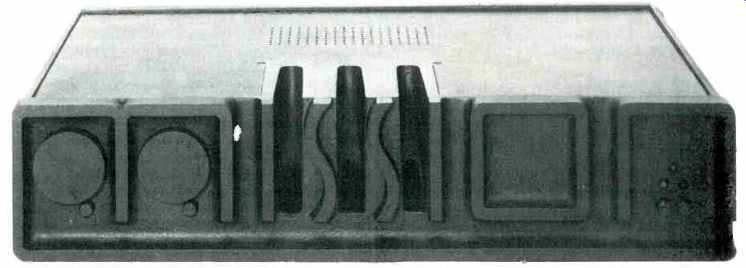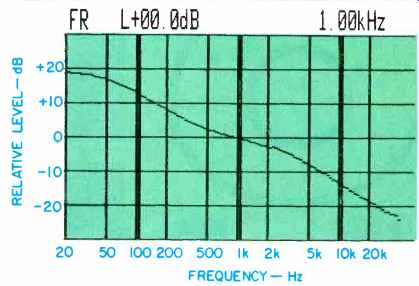
Manufacturer's Specifications
Input Sensitivity: Phono, 2.0 mV for 1-V out; line, 100 mV for 1-V out.
Phono Overload: 150 mV at 1 kHz.
Nominal Output Level: 1 V rms.
Maximum Output Level: 11 V peak.
Phono Input Impedance: 47 kilohms, 150 pF.
Output Impedance: 250 ohms.
Signal-to-Noise Ratio: Phono, 80 dB, A wtd., re: 5 mV input; line, 95 dB, CCIR wtd., re: 200 mV input.
THD: Less than 0.05%, 20 Hz to 20 kHz.
SMPTE IM: Less than 0.05%.
TID: Zero.
Frequency Response: Phono, RIAA, ±0.2 dB; line, 20 Hz to 20 kHz,-0.1 dB.
Weight: 25 lbs. (11.36 kg).
Price: $997.00.
I had not ever heard of Mission Electronics until their impressively heavy carton arrived, containing their Model 776 preamp. As my local deliverer handed the package to me, I felt sure that a mistake had been made and that the company had actually sent their matching power amplifier (the Model 777). The mystery was solved when I opened the package and discovered that Mission Electronics (with facilities in Canada and the U.K.) chose to use a very heavy casting as the foundation for this preamplifier, which is quite "lightweight" in terms of control features and switches. As stated in their preamble on design philosophy in the owner's manual, the folks at Mission "strongly believe in straight line amplifier design, eliminating all unnecessary, fancy and harmful features offered by most designs on the market." While I would certainly agree that the heavy casting (which manages to sculpt the letters MISSION in the form of a massive front panel) is not "harmful," it certainly is "fancy" and, with all due respect, "unnecessary." Leaving aside the aesthetic question of whether one will be attracted to this extremely robust design package, I do wish that Mission had not gone quite so far in eliminating the extras. While the volume control is easy enough to identify, since it has a circle of progressively larger dots molded into the knob, the source selector doesn't identify which dot is for which program, nor are the positions of the tape monitor and the mono/stereo pushbuttons labeled.
While this potential confusion will probably not be a factor after the first couple of uses, I do not think it would have harmed the design at all had the front of the casting carried tiny nomenclature letters. There isn't much more to say about front-panel controls because I've just named them all.
There is a fair amount to say about the circuitry of this preamp, which I must admit, is superbly conceived and equally superbly crafted and assembled. The 776 is modular in construction. The few switches and connectors used are of extremely high quality, in some cases of military grade, with gold-plated contacts. The layout of modules minimizes the length of interconnecting tracks, and most circuit paths are doubled up on both sides of the printed circuit modules to reduce resistance. Where coupling capacitors were needed in the signal path, polyester-film capacitors have been mixed and doubled up to reduce what Mission terms the "sonic signature" of one type or make. Similarly, 1% metal-film resistors are used throughout the preamp.
Perhaps the most unusual part of the design is the power supply, which is actually derived from two rechargeable, sealed batteries which provide 25 V d.c. at 1.5 ampere/hour capacity. The supply voltage goes through two stages of filtering, first 10,000 µF and then 2,200 µF, and then is separated into two channels, which are decoupled by means of 4.7-µF polyester-film capacitors. Mission's intent with this design is to ensure no line-induced hum, low input impedance over the audio spectrum, and high interchannel rejection. The battery recharging system is interesting in that when the preamp is actually playing, all a.c. line input is cut off; when it is not in use, the system goes into full charge mode, switching over to trickle charge when the battery is within 97% of full charge. Mission says that the battery will deliver optimum performance for at least 20 hours of continuous use.
The phono stage of the 776 uses a low-noise differential amplifier followed by a current-pumping, voltage-amplifier stage. There is no arbitrary roll-off of the RIAA curve at the low end in order to ensure phase accuracy at extreme bass frequencies. Overall feedback in this stage is less than 10 dB at 20 Hz. The line amplifier stage is a simple common emitter stage followed by a current-pumping voltage amplifier. Overall feedback in this stage is less than 20 dB with an output impedance of 200 ohms.
The preamplifier module has a gain of 54 dB, making it suitable for all moving-magnet cartridges and some high output moving-coil cartridges. Input loading for the cartridge can be changed by inserting appropriate low-noise input resistors across the input plug-in component sockets on the rear of the preamplifier.
The back panel of the 776 features a detachable line cord and a line fuse housing, the preamp output jacks, tape output jacks, tape in jacks, AUX and phono input jacks, a ground terminal, and a balance control which is outside the signal path of the preamplifier and can be adjusted in 1 dB steps to a maximum of 4 dB. Balance adjustments are achieved by switching parallel resistors in the feedback loop.
Measurements
Input sensitivity (for 0.5-V output) measured 1 mV at 1 kHz for the phono inputs and 55 mV for the line (high) level inputs of the Model 776 preamplifier. The phono inputs were able to handle 180 mV of input before overload distortion of the phono-equalizer stage was evidenced. Total harmonic distortion, via the line inputs, measured a mere 0.0025% at 1 kHz, increasing insignificantly to 0.02% at 20 Hz and 20 kHz, still well below the published figures of 0.05% and certainly orders of magnitude below audibility.
SMPTE-IM distortion measured 0.0045% (for nominal 1-V output), and I could detect no trace of intermodulation products when I attempted to measure CCIR or IHF IM distortion using the equal-amplitude twin-tone method which applies to these two types of tests.
Signal-to-noise ratio for the phono inputs measured a very high 87 dB, while for the line inputs it was 90 dB. Both measurements are referenced to 0.5-V out, with 5-mV input in the case of the phono circuits and 0.5-V in for the line amplifier. Despite the fact that during operation of the Model 776 all a.c.-line input current never gets beyond the cord, there was nevertheless an improvement noted when the line cord was physically disconnected from the rear of the unit, and it was in this mode that the above readings were obtained. Since S/N figures with the cord connected were between 2 and 4 dB worse, I would urge users of this preamplifier to connect the cord only when recharging the battery and when not using the preamplifier during music reproduction.
I plotted the RIAA response curve for the Mission 776 from 20 Hz out to beyond 20 kHz, and the results are shown in the video printout of Fig. 1. Notice that there is no roll-off observed at the extreme bass end of the curve, confirming Mission's claim that they allow the RIAA equalization network to continue all the way down to infrasonic frequencies.
While this makes for excellent bass reproduction and accurate phase response, it does demand that a very high quality, rumble-free turntable be used with this equipment, especially since there is no built-in subsonic filter circuitry.
Even moderately warped recordings could have an adverse effect on sound reproduction quality given this kind of extended boost in the RIAA response curve.

Fig. 1--RIAA playback characteristic.
Use and Listening Tests
Certainly, the sound reproduction quality of this preamplifier comes about as close to the idealized "straight wire with gain" as that of any preamplifier I have auditioned in recent months. My own feeling is that even though Mission wants the product to be as free of extra frills as possible, having a second tape-monitor circuit for tape-to-tape copying would in no way detract from the straightforward signal-path approach they espouse. I rather wish that I had had the company's matching (and 10 pounds heavier) Model 777 through which to listen to the 776, so that I might have judged the system as a whole. The owner's manual deals with both of these products, alternately skipping back and forth in its discussions from the preamplifier to the amplifier as if they were meant to be purchased as an inseparable pair. Stacked above each other, they would read:
MISSION
MISSION
Alone, the 776 seems, somehow, like a Mission that's incomplete....
-Leonard Feldman
(adapted from Audio magazine, Jun. 1982)
Also see:
Mission 735 Speaker (Jan. 1996)
McIntosh MX-117 Tuner-Preamp (Jun. 1982)
MTI Model 500 Preamp (May 1981)
= = = =